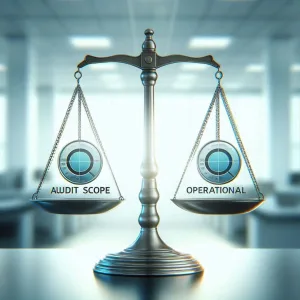Credit risk assessment is a critical process within the realm of internal auditing, serving as a cornerstone for maintaining financial stability in organizations. Using a credit risk assessment template can significantly streamline this process. It involves evaluating the potential for loss due to a borrower’s failure to meet contractual obligations, which can significantly impact an institution’s profitability and overall health. By systematically analyzing credit risk, internal auditors can help organizations identify vulnerabilities and implement strategies to mitigate potential losses.
Accurate credit risk evaluations are paramount for organizations, as they directly influence decision-making processes related to lending, investment, and risk management. A well-executed credit risk assessment not only safeguards the financial interests of the organization but also enhances its reputation and trustworthiness in the market. When organizations fail to conduct thorough evaluations, they expose themselves to unforeseen risks that can lead to substantial financial repercussions.
However, the process of credit risk assessment is fraught with potential pitfalls that can undermine its effectiveness. Internal auditors must be vigilant in recognizing and avoiding these common mistakes to ensure that their evaluations are both comprehensive and reliable. By understanding these pitfalls, auditors can enhance their methodologies, leading to more accurate assessments and better risk management practices. This section will delve into the common errors encountered in credit risk assessments, providing insights for internal auditors and risk managers to refine their approaches and bolster their organizations’ financial resilience.
Understanding Credit Risk Assessment
Credit risk assessment is a critical process for internal auditors and risk managers, as it helps organizations identify and mitigate potential losses arising from borrower defaults or deteriorating credit quality. A well-structured credit risk assessment template can serve as a valuable tool in this evaluation process. Below are key components, standard practices, and the importance of data integrity in credit risk assessments.
Components of a Credit Risk Assessment Template
- Borrower Information: This section should include detailed information about the borrower, such as their credit history, financial statements, and any relevant background information. Understanding the borrower’s profile is essential for accurate risk evaluation.
- Credit Exposure: This component assesses the total amount of credit extended to the borrower, including loans, credit lines, and any other financial commitments. It is crucial to quantify exposure to understand potential losses.
- Risk Factors: Identifying specific risk factors that may affect the borrower’s ability to repay is vital. This includes economic conditions, industry trends, and borrower-specific issues such as management quality and operational risks.
- Credit Scoring Models: Utilizing standardized scoring models can help in quantifying credit risk. These models often incorporate various financial ratios and metrics to provide a comprehensive risk assessment.
- Mitigation Strategies: The template should outline potential strategies to mitigate identified risks, such as collateral requirements, guarantees, or insurance. This proactive approach can help reduce overall credit risk.
Standard Practices for Evaluating Credit Risk
- Regular Reviews: Conducting periodic reviews of credit risk assessments ensures that they remain relevant and accurate. This practice helps in adapting to changing market conditions and borrower circumstances.
- Diversification: Spreading credit exposure across various borrowers and sectors can reduce the overall risk of loss. Internal auditors should encourage diversification as a standard practice in credit risk management.
- Documentation: Maintaining thorough documentation of the assessment process is essential. This includes recording the rationale behind risk ratings and decisions made, which can provide valuable insights during audits.
- Collaboration: Engaging with other departments, such as finance and compliance, can enhance the credit risk assessment process. Collaboration ensures that all relevant information is considered, leading to more informed decisions.
Importance of Data Integrity and Analysis Methods
Data integrity is paramount in credit risk assessments. Inaccurate or incomplete data can lead to flawed evaluations, resulting in significant financial repercussions. Internal auditors should prioritize the following:
- Data Validation: Implementing robust data validation processes ensures that the information used in assessments is accurate and reliable. This includes cross-referencing data from multiple sources.
- Analytical Techniques: Employing advanced analytical methods, such as statistical modeling and trend analysis, can enhance the quality of credit risk evaluations. These techniques help in identifying patterns and predicting potential defaults.
- Continuous Monitoring: Establishing a system for continuous monitoring of credit risk factors allows organizations to respond promptly to emerging risks. This proactive approach is essential for maintaining the integrity of the credit risk assessment process.
Data Validation: Implementing robust data validation processes ensures that the By understanding the components of a credit risk assessment template, adhering to standard evaluation practices, and ensuring data integrity, internal auditors can significantly enhance their credit risk evaluations. Avoiding common pitfalls in these areas will lead to more accurate assessments and better risk management outcomes.
Common Pitfalls in Credit Risk Assessment
In the realm of internal auditing, particularly concerning credit risk assessments, there are several common pitfalls that can significantly undermine the effectiveness of evaluations. Internal auditors and risk managers must be vigilant in avoiding these mistakes to ensure robust credit risk management. Here are some key points to consider:
- Overreliance on Historical Data: One of the most significant errors is depending too heavily on historical data without factoring in current market conditions. While past performance can provide insights, it may not accurately reflect the present or future creditworthiness of borrowers, especially in volatile economic climates. Auditors should integrate real-time data and market trends into their assessments to enhance accuracy.
- Neglecting Qualitative Factors: Many assessments focus predominantly on quantitative metrics, such as credit scores and financial ratios, while overlooking qualitative factors that can influence credit risk. Elements like management quality, industry position, and market reputation are crucial for a comprehensive evaluation. Internal auditors should strive to balance both qualitative and quantitative analyses to gain a holistic view of credit risk [4].
- Ignoring Economic Changes: Economic fluctuations can have a profound impact on the creditworthiness of borrowers. Failing to consider these changes can lead to outdated assessments that do not reflect the current risk landscape. Internal auditors must regularly review and adjust their evaluations in light of economic indicators and trends to maintain relevance.
- Inadequate Updates to Risk Assessments: Regular updates to risk assessments are essential for maintaining their effectiveness. Many organizations fall into the trap of conducting assessments infrequently, which can result in outdated information that does not capture the current risk environment. Internal auditors should establish a routine for revisiting and revising assessments to ensure they remain aligned with the latest data and conditions [1].
- Lack of Training and Expertise: The effectiveness of credit risk assessments can be compromised by inadequate training and expertise among staff responsible for conducting these evaluations. Internal auditors should ensure that their teams are well-trained in both the technical aspects of credit risk assessment and the broader economic context. Continuous professional development is vital for maintaining high standards in risk evaluation [5][15].
- Insufficient Collaboration Between Departments: Effective credit evaluations often require input from multiple departments, including finance, risk management, and compliance. A lack of collaboration can lead to fragmented assessments that miss critical insights. Internal auditors should promote interdepartmental communication and teamwork to enhance the quality and comprehensiveness of credit risk evaluations [3][6].
By recognizing and addressing these common pitfalls, internal auditors can significantly improve the accuracy and reliability of credit risk assessments, ultimately contributing to better risk management practices within their organizations.
Consequences of Poor Credit Risk Assessments
Inadequate credit risk evaluations can have far-reaching negative outcomes for organizations. Internal auditors and risk managers must be aware of these potential pitfalls to ensure robust credit risk management practices. Here are some key consequences of poor credit risk assessments:
- Increased Financial Loss Due to Unrecognized Credit Risks: Failing to accurately assess credit risk can lead to significant financial losses. Organizations may find themselves exposed to defaults or deteriorating credit quality of borrowers or counterparties, which can severely impact profitability and solvency [4][9].
- Damage to Organizational Reputation and Stakeholder Trust: Poor credit risk assessments can erode stakeholder confidence. When organizations fail to manage credit risks effectively, it can lead to a loss of trust among investors, clients, and partners, ultimately harming the organization’s reputation in the market.
- Regulatory Scrutiny and Compliance Issues: Inadequate credit risk management can attract regulatory scrutiny. Organizations may face compliance issues if they do not adhere to established guidelines and standards for credit risk assessment, leading to potential fines and legal repercussions [3][12].
- Impact on Strategic Decision-Making and Resource Allocation: Poor credit risk evaluations can hinder effective strategic decision-making. When internal auditors do not provide accurate assessments, it can lead to misallocation of resources and misguided strategic initiatives, ultimately affecting the organization’s long-term goals and objectives [1].
Increased Financial Loss Due to Unrecognized Credit Risks: Failing to accuratelyBy recognizing these consequences, internal auditors can better understand the importance of thorough and accurate credit risk assessments, thereby enhancing their organization’s risk management framework and overall financial health.
Best Practices for Effective Credit Risk Assessment
In the realm of internal auditing, particularly concerning credit risk assessment, avoiding common pitfalls is crucial for ensuring accurate evaluations. Here are some best practices that internal auditors and risk managers should adopt to enhance their credit risk assessment processes:
- Develop a Comprehensive Credit Risk Assessment Template: A well-structured template serves as a foundational tool for conducting thorough credit risk assessments. It should encompass all relevant factors, including borrower creditworthiness, market conditions, and potential exposure levels. This comprehensive approach ensures that no critical elements are overlooked, thereby enhancing the reliability of the assessment.
- Encourage Regular Training and Development for Audit Staff: Continuous education is vital for internal auditors to stay updated on the latest trends, regulations, and methodologies in credit risk management. Regular training sessions can equip audit staff with the necessary skills and knowledge to identify and mitigate risks effectively. This investment in human capital not only improves individual performance but also strengthens the overall audit function [5].
- Implement Ongoing Monitoring and Updates to Risk Assessments: Credit risk is not static; it evolves with changing market conditions and borrower circumstances. Therefore, it is essential to establish a process for regular reviews and updates of risk assessments. This proactive approach allows organizations to adapt to new risks and ensures that the assessments remain relevant and accurate over time [6].
- Promote Collaboration Between Departments for a Holistic Approach: Effective credit risk assessment requires input from various departments, including finance, compliance, and operations. By fostering collaboration and communication among these teams, organizations can gain a more comprehensive understanding of credit risks. This holistic approach not only enhances the quality of assessments but also facilitates the sharing of insights and best practices across the organization [4].
- Utilize Technology and Data Analytics to Enhance Assessment Accuracy: Leveraging technology and data analytics can significantly improve the accuracy and efficiency of credit risk assessments. Advanced analytical tools can help auditors identify patterns, trends, and anomalies in credit data, enabling more informed decision-making. By integrating these technologies into the assessment process, organizations can enhance their ability to predict and manage credit risks effectively [8].
By adhering to these best practices, internal auditors and risk managers can avoid common pitfalls in credit risk assessment, ultimately leading to more accurate evaluations and better risk management outcomes.
Conclusion
In the realm of internal auditing, particularly concerning credit risk assessments, the accuracy and reliability of evaluations are paramount. An effective credit risk assessment not only safeguards the financial health of an organization but also ensures compliance with regulatory requirements and internal policies. Internal auditors play a crucial role in this process, and understanding the common pitfalls can significantly enhance the quality of their evaluations.
- Significance of Accurate Credit Risk Assessments: Accurate credit risk assessments are foundational to identifying potential financial losses and ensuring that organizations can make informed lending decisions. They help in mitigating risks associated with borrower defaults and contribute to the overall stability of the financial system. A robust assessment process can prevent material misstatements and enhance the integrity of financial statements, which is essential for maintaining stakeholder trust [2].
- Learning from Common Pitfalls: Internal auditors must be vigilant about the common mistakes that can undermine credit risk evaluations. These include poor prioritization, lack of documentation, and human errors exacerbated by manual processes. Additionally, failing to adapt to regulatory changes or neglecting to address internal control weaknesses can lead to significant oversights [3][5]. By recognizing these pitfalls, auditors can take proactive steps to avoid them, thereby improving the effectiveness of their assessments.
- Incorporating Best Practices: It is imperative for internal auditors and risk managers to incorporate best practices into their credit risk evaluation processes. This includes establishing clear documentation protocols, utilizing automated systems to reduce human error, and ensuring continuous training to keep pace with evolving regulations and risk landscapes. By fostering a culture of diligence and adaptability, organizations can enhance their credit risk assessment frameworks and ultimately protect their financial interests [6][7][8].
In summary, the importance of accurate credit risk assessments cannot be overstated. By learning from common pitfalls and committing to best practices, internal auditors can significantly improve their evaluations, thereby contributing to the overall risk management strategy of their organizations.
Find out more about Shaun Stoltz https://www.shaunstoltz.com/about/
This post was written by an AI and reviewed/edited by a human.



